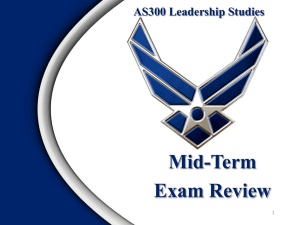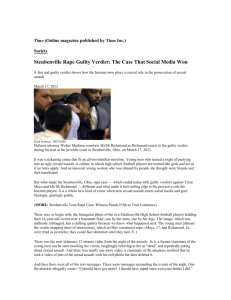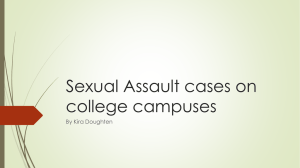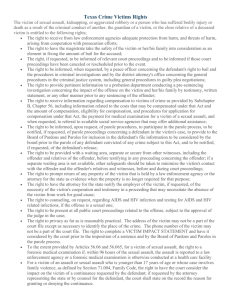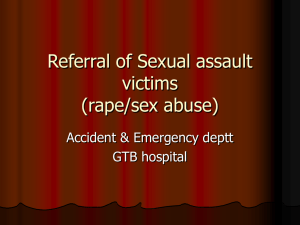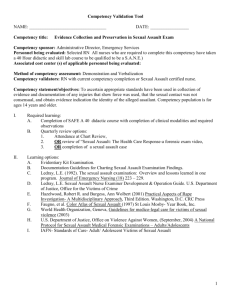SAFE Exam - Awhonn
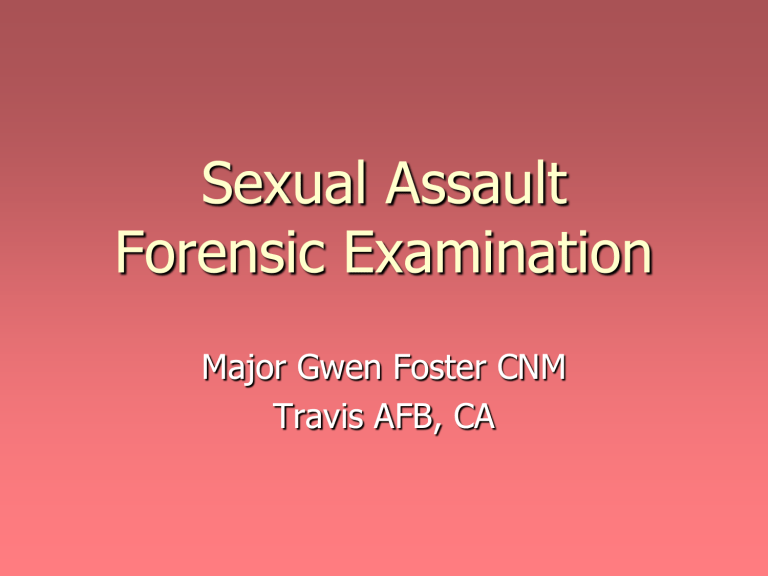
Sexual Assault
Forensic Examination
Major Gwen Foster CNM
Travis AFB, CA
Objectives
Governing Policies
Reporting Rules
Role of Sexual Assault Examiner
SAFE KIT
Sexual Assault Policies
Department of Defense Directive 6495.01
Department of Defense Directive 6495.02
Army Regulation 600-20, Chapter 8 and
Appendix 1
AFI 36-6001, Sexual Assault Prevention and Response Program
Reporting Rules
Restricted (Confidential)
Unrestricted
Role of Sexual Assault Examiner
Diagnosis and treat within scope of practice
Head to toe assessment
ID, collect, preserve and document evidence and maintain chain of custody
Refer for appropriate treatment and follow-up
Provide expert testimony in a court of law
Forensic Examination
PRIMARY ASSESSMENT
Physical, mental and emotional care
SECONDARY ASSESSMENT
ID, collect, preserve and document evidence
Determine if evidence consistent or inconsistent
Forensic Examination (cont.)
Within 72 hours
Yields the highest quality evidence
After 72 hours
Significant healing of trauma
Trace evidence may be lost through natural processes and or actions of the individual being examined
But…
Forensic Examination (cont.)
Sperm heads - 19 days post-assault
Epithelial cells - 3 weeks post-assault
Evidence Transfer
Locard’s Principle of Evidence Transfer
partial transfer of material from one to the other
Minimum of Three Crime Scenes
Victim
Suspect
Location of crime
Use physical evidence to tie the scenes together
Evidence Transfer
Evidence Transfer (cont.)
Trace Evidence: small pieces of evidence
Direct (Primary) Transfer
Direct contact between suspect/victim/scene
Indirect (Secondary)
Transfer
Carried from location to other locations
Overview of the Exam
Forensic interview
A sexual assault examination kit
Victim Interviewing
Ensure safe and supportive environment
Influences –
quality of the history
cooperation during the exam
Patient attitude toward legal proceedings
Primary/Secondary Assessment
Head to Toe
Inspect/photograph
Collect
Palpate
Document
Equipment
During examination:
Camera
Colposcope/anoscope
Toluidine Blue
Woods lamp
Swab dryer
After examination:
Clothing
Medications
Step 1
Authorization
Victims: Must agree to exam
If refuse, encourage to have medical exam
Subjects: Not necessary if taken under search authority or warrant
AFI 44-102 2.35.2.4.
Step 2
History and Assault Information
VICTIM’s statements are placed in quotations
Step 2 (cont.)
Interview
History is critical
Guides subsequent examination for forensic evidence
Corroborates physical findings
Use open-ended questions - avoid yes and no
Tell me what happened.
What happened next?
Tell me about the bruise on your face.
Step 2 (cont.)
Information to include:
Identifying data
Date and time of assault
Number of attackers, weapons used, restraints exact threats,
Location of the assault
Position of VICTIM during assault
Sequence of contact and penetration
Step 2 (cont.)
Information to include:
Vaginal/Anal contact
Oral contact
Ejaculation
Injuries inflicted upon SUBJECT
Actions following assault
Step 2 (cont.)
Pertinent past medical history:
Last Menstrual Period (LMP)
Last consensual sexual contact (identify partner)
Medication use
Alcohol and drug use by SUBJECT and VICTIM
Step 3
Clothing/Foreign material
Seal each bag and label it
One paper bag for each piece of clothing
VICTIM will completely disrobe
Have a gown ready
Inspect/Photograph
Examine with a Wood lamp
Photodocumentation I
Camera Photography of trauma
Macro ability
Use in same plane of injury
Step 3
(cont.)
Use of Wood lamp
Fluoresces semen stains
Augment marks and pattern injuries
Detect saliva and vaginal fluid
Step 3 Envelopes
Step 4
Debris Collection
Collect any debris detected, i.e. clumps in hair, grass on body, etc.
Collect any swabs taken from dried secretions
Step 4 (cont.)
Collect scrapings from underneath the victim’s fingernails
Useful if the victim fought off the offender
Recommended to collect even if no report of having fought back
Step 5
Pubic Hair Combings
Combed to collect any debris
Paper is placed beneath victim
Step 6
Pulled/cut pubic hairs
Purpose is to serve as control
Recommended by some law enforcement agencies
Step 7
Vaginal swabs/smears
Inspect/Photograph
Colposcopy
Toluidine Blue dye application
Completed before speculum insertion
Photodocumentation II
Colposcope photography
External genitalia
Injuries
External internal anal
Toluidine Blue dye (injury enhancement)
Apply last
Repeat injury pictures
Toluidine Blue Dye
Step 8
Rectal swabs/smears
Anus should be visualized to ensure there is no trauma
Step 9
Oral swabs/smears
Non-invasive procedure, always collect
Step 10
Pulled/cut head hairs
Minimum of 5 fulllength hairs from each section: center, front, back, left and right sides
Step 11
Known Blood Samples
In addition to collecting blood for
DNA comparison, blood may be collected for toxicological analysis
Step 12
Anatomical Drawings
Document location of all injuries
Narrative descriptions should corroborate documentation
Sexually Transmitted Diseases
Pre-testing is not advised, results may be admissible in court
STD cultures are not part of forensic exam
Treatment Protocols
Vary from program to program
Not 100% effective
Give information on how and when to follow-up for care and STD testing
Signs and symptoms to report
STD Prophylaxis
CDC Recommendation
Ceftriaxone 125 mg IM in a single dose
PLUS
Metronidazole 2 g orally in a single dose
PLUS
Azithromycin 1 g orally in a single dose
OR
Doxycycline 100 mg orally twice a day for 7 days
Additional Follow-up Issues
Refer to counseling
HIV and HBV testing are recommended and are available free of charge at appropriate locations
All patients should be urged to follow-up with testing if symptoms develop
Pregnancy Prevention
This is prevention not pregnancy termination
Emergency contraception used to prevent pregnancy following unprotected intercourse
Emergency Contraception
Should be given within 72 hours of assault for effective prophylaxis
Medication given in two doses 12 hours apart
Should be advised to follow up if regular periods do not resume
Instruct patient to contact ER if any severe side effects
Common
Dangerous
Follow up
Victim should follow up with medical provider if anything just doesn’t “seem right”
Follow up information for counseling services
SARC/Victim Advocate
Follow up (cont.)
After patient has left
Write report
DOCUMENT, DOCUMENT, DOCUMENT
Do not draw legal conclusions
Allow specimens to dry
Give evidence to investigator
Proper chain of custody
Finishing the Examination
Implications
Patient is the Crime Scene
“Evaluation must be documented…for possible use in future legal actions”
“Consequence to patient, accused, hospital and provider may result from a failure to do so”
(Smock ,2006)
Questions
References
http://www.brooksidepress.org/Products/Military_
OBGYN/Textbook/Assault/Assault.htm
http://www.cdc.gov/std/treatment/2006/sexualassault.htm
http://www.safeta.org/ http://www.sapr.mil/
Distress and Pain During Pelvic Examinations:
Effect of Sexual Violence. Obstetrics &
Gynecology. 112(6):1343-1350, December 2008.
Olshaker, J., Jackson, C., Smock, W. Forensic
Emergency Medicine (2 nd ed). Lippincott, Williams
& Wilkins. Philadephia, PA 2006.

